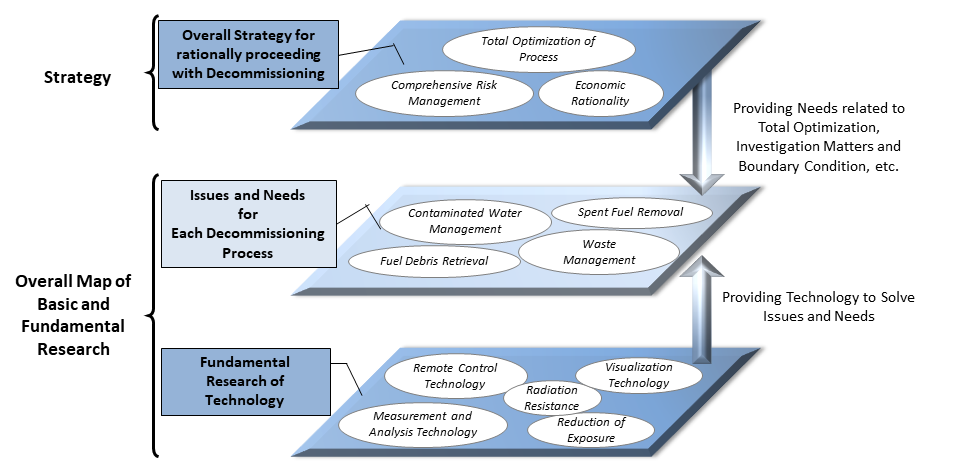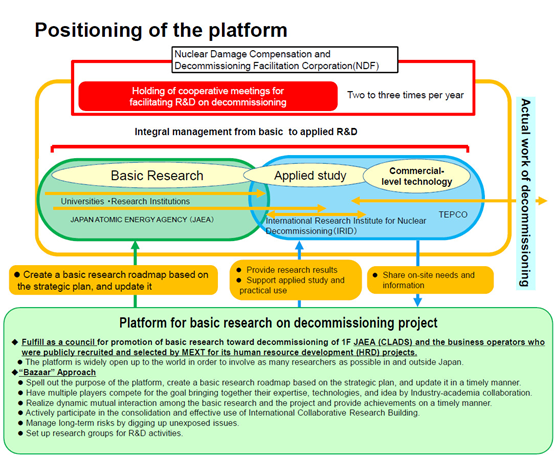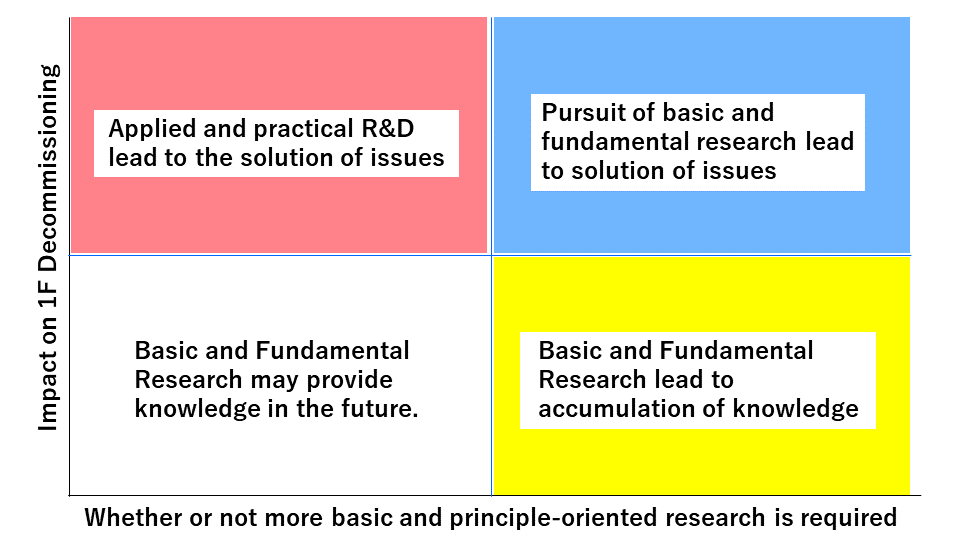
Decommissioning Science Diagram
Decommissioning Science Diagram (FY2025)
Click above diagram to see the detailed version
Please note that this English text is a provisional translation of the Japanese original
Click here for the detailed version (Detailed Version PDF)
Click here for a list of issues
Download all diagrams (diagram_en.zip, 9.8MB)
1. What is the Decommissioning Science Diagram?
“Decommissioning Science Diagram” is a two-dimensional mapping of the three-layered structure of “Overall Strategy for rationally proceeding with Decommissioning”, “Issues and Needs for Each Decommissioning Process” and “Fundamental Research of Technology”.

Figure: Overall structure of “Decommissioning Science Diagram”
“Decommissioning Science Diagram” provides a bird's eye view of the entire decommissioning from contaminated water management to processing, disposal and environmental remediation, and shows the correlation between the needs in each decommissioning process, thereby organizing the issues to be solved in basic and fundamental research.
“Decommissioning Science Diagram (Detailed Version)” provides detailed information on the selected needs one by one.
In order to proceed with the 1F decommissioning project in a rational manner, it is necessary to identify important research issues that are considered necessary not only for the present but also for the future, along with the timing and method of implementation. For this purpose, by investigating of matching of project needs and research seeds, important untouched or buried (unnoticed) research issues for the entire project should be uncovered and presented as essential research issues. In addition to updating “List of Basic and Fundamental Research Issues on Decommissioning”, which have been worked on, the relationship between needs and seeds would be organized and “Decommissioning Science Diagram” to meet the above requirements would be created.
2. Background (Motivation)
The Japan Atomic Energy Agency (hereafter, “JAEA”) established the Collaborative Laboratories for Advanced Decommissioning Science (hereafter, “CLADS”). Considering “Mid-and-Long-Term Roadmap towards the Decommissioning of TEPCO's Fukushima Daiichi Nuclear Power Station” revised in December 2019 , CLADS has been conducting R&D for the decommissioning of TEPCO's Fukushima Daiichi Nuclear Power Station (hereinafter referred to as “Decommissioning”).
The Decommissioning is carried out in accordance with “Technical Strategic Plan for Decommissioning of the Fukushima Daiichi Nuclear Power Station of Tokyo Electric Power Company Holdings, Inc." (hereinafter “Strategic Plan”) of the Nuclear Damage Compensation and Decommissioning Facilitation Corporation (hereinafter “NDF”).

Figure: Overview of the R&D structure of the decommissioning of Fukushima Daiichi NPS (As of FY 2021) (Technical Strategic Plan 2021 for Decommissioning of the Fukushima Daiichi Nuclear Power Station of Tokyo Electric Power Company Holdings, Inc. /
October 29, 2021 / Nuclear Damage Compensation and Decommissioning Facilitation Corporation / pp.112)
Based on the decision at a meeting of the Team for Countermeasures for Decommissioning and Contaminated Water Treatment, “Decommissioning R&D Partnership Council” meets regularly for efficient solution of R&D. JAEA has organized “Platform of Basic Research for Decommissioning” to serve as a driving force for basic and fundamental research. In this platform, “Decommissioning Science Diagram Based on the Strategic Plan” is required to be presented and updated.

JAEA has been organizing “List of Basic and Fundamental Research Issues on Decommissioning” . Upon taking over “Project for Promoting Nuclear S&T and Human Resource Development by Collecting Wisdom” (hereinafter referred to as the “Wisdom Project”) , which had been implemented by the Ministry of Education, Culture, Sports, Science and Technology (MEXT) since FY2018, JAEA has strengthened cooperation with academia and established an organization for more stable and continuous implementation of mid- to long-term R&D and human resource development for the decommissioning, and has organized “Decommissioning Science Diagram”, which provides a bird's eye view of the decommissioning.
“Decommissioning Science Diagram” will be continuously updated as the needs and the importance of such needs change with the progress of decommissioning.
3. Evaluation of Importance of Needs
In order to promote the decommissioning research, the importance of needs is evaluated by experts from the viewpoint of basic and fundamental research. Based on their evaluation, it is possible to contribute to efficient research through selection and concentration of research resources by classifying the needs into four categories. When there are mixed evaluations, they are represented by two colors.

○The evaluation is based on the following two axes:
(1) Impact (the degree of impact on the entire 1F decommissioning (risk, process, cost) if the issue is not resolved);
(2) Whether or not more basic and principle-oriented research is required.
○Evaluation indicators for each axis
(1) Impact (the degree of impact on the entire 1F decommissioning (risk, process, and cost) if the issue is not resolved)
(1.1) Impact on risk, process, and cost if the issue is not resolved
(1.2) Degree to which there is little prospect that the issue can be resolved by current technology and knowledge, and thus R&D is required.
(2) Whether or not more fundamental and principle-oriented research is required
(2.1) The elucidation of the mechanism and the establishment of a theory are required
(2.2) An explanation based on scientific evidence is required
(2.3) Accumulation is required, and it will take time to resolve